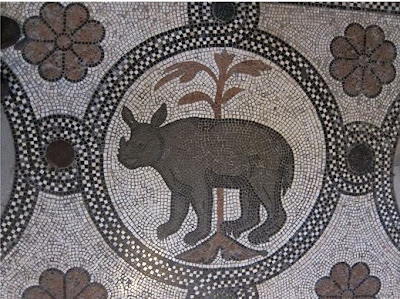This graffiti of a man with a long pipe, found on a column of the Palazzo Loredan, refers to a local legend about a fisherman called Biagio. Supposedly, one day while Biagio was standing outside the palace, Satan, in the form of a monster, reared out of the canal and snatched two young girls from a gondola.
Whe Biagio begged him to release the girls, Satan said he would consent, but only if Biagio's arms could embrace the entire world. Magically, the fisherman's arms flew from his body, and, assisted by cherubim, circled the globe. Satan, stunned, disappeared, leaving Biagio and the girls unharmed.
Whe Biagio begged him to release the girls, Satan said he would consent, but only if Biagio's arms could embrace the entire world. Magically, the fisherman's arms flew from his body, and, assisted by cherubim, circled the globe. Satan, stunned, disappeared, leaving Biagio and the girls unharmed.
On a house a few steps from St Mark's Square is this sculpted plaque. It commemorates an incident in 1310, when a group of rebels started making trouble in the city. The old woman in the house threw a mortar from her window, and managed to kill the chief rebel's standard bearer on the spot. As a reward, the rent on her home was never raised.
This unusual rhinoceros mosaic in St Mark's Basilica has been a subject of furious debate for years, with scholars split over whether it dates from the 13th, 15th, 16th, 18th or even 20th centuries. Some believe that the rhinoceros – the first of which probaby came to Venice in 1751 – symbolises strength, while others say it was thought to ward off illness.
Among the rows of white columns of the Doge's Palace, two are a pale pink. According to legend, they mark the spot where the doge used to stand during ceremonies, and from where death sentences were read out to the crowd below.
On a building close to the Pescheria Nuova (New Fish Market), overlooking the Grand Canal, is a marble plaque set up by the City Council many years ago which shows the minimum length each type of fish sold must be. The rules were intended to protect fish during the breeding season, and still apply today.
Another piece of memorable Venetian graffiti, this time not far from the church of San Canciano. Scratched into a column, the graffiti commemorates the "great freeze" of 1864, when "people could walk across the ice as far as the island of San Michele". Supposedly, the ice on the lagoon was so thick that year it could bear sledges.
The Venetians loved nothing better than to see, and to be seen; how else to explain the extraordinary number of spyholes around the city? This tile can be found on the first floor of the Casa Goldoni, and was used by the owner of the house to see who was arriving at the gate below.
Not far from Casa Goldoni is a house which displays an unnerving sculpture of a woman's head, known as "The Honest Woman". Various stories exist about the sculpture; some say it commemorates a prostitute famed for her reasonable rates, while others say the house was once the home of a beautiful woman who killed herself after being raped.
This wooden door at the Hotel Metropole is part of what was once a "foundlings' wheel", set in the wall of a former convent on the site. Parents would abandon their children in a kind of rotating cradle, which then brought the foundlings inside.
The garden of the former Palazzo Rizzo-Patrol, now the Hotel des Doges, is home to an old icehouse which is almost hidden away behind shrubbery. Built from brick, it would have been filled with blocks of ice and used to keep food for the palace cool.
When visiting the fish market, it's also worth casting a glance upwards to admire the ornately carved columns around the exterior. They are decorated with all kinds of sea creatures, from lobsters, to squid, to seahorses, while one shows boats laden down with vieri (the large baskets traditionally used to carry fish to market).
Hidden away beneath the church of San Simeone Piccolo is an eerie cemetery whose walls are covered with 18th-century frescoes inspired by the themes of death, the Last Judgement and Christ's Passion, and filled with human bones. There are no official visits organised to the cemetery, but if you ask one of the members of the Fraternity of St Peter (who look after the church) to let you see it at the end of Sunday mass, you could be given access.
This red stone in the sotoportego de la corte nova dates back to an incident during the plague of 1630, which killed more than 50,000 people in Venice alone. A young girl named Giovanna placed a painting of the Holy Virgin and three saints in the courtyard where the people prayed and amazingly, although the plague continued, it did not affect anyone beyond the picture. A slab of red marble was soon installed to commemorate the miracle.
Fuente...













Comments (0)
Publicar un comentario